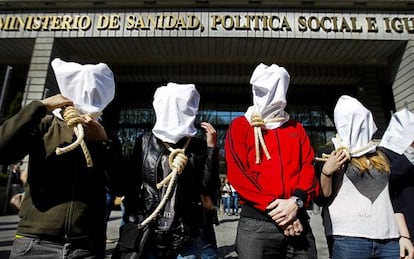Cuts to HIV programs hindering efforts to combat new infections
Spain has one of the highest incidence rates in Europe, say health professionals

Drastic cuts in money destined for HIV-prevention programs may thwart Spain's attempts to control the high rate of new infections, or even its ability to bring it down to the European average, the medical community and NGOs have warned.
In the last five years, AIDS awareness and HIV prevention groups have lost 50 to 70 percent of their budgets due to government cutbacks, according to calculations made by EL PAÍS.
"The absence of a new strategic plan for HIV validates the fact that citizens' health is not a major priority for this government," said one NGO official on Wednesday.
, there is also a lack of adequate prevention strategies coming from the government."
, there is also a lack of adequate prevention strategies coming from the government."
The Health Ministry gives money from its own budget in the way of subsidies to groups involved in prevention and awareness programs. However, those funds have also diminished over the past few years. In 2008, there were 4.2 million euros designated for the NGOs, but this year only 1.1 million euros have been made available by the ministry. Last year, money appropriated for those subsidies was drastically cut to one million euros.
The third source of financing for these types of programs is the money the central government transfers annually to the regions. In 2008, some 4.8 million euros was made available for local prevention and control groups, but that figure was reduced to 4.3 million in 2011. Figures for 2012 are no longer listed separately in the government's annual health report on HIV and AIDS. Ministry sources explained that the money is now included in a global cohesion fund designed for the regions.
But the Alliance of Platforms in the Fight Against HIV - a group that includes 12 organizations - said it has no knowledge where the money is. "The regions tell us that they have not received the funds," said Montse Pineda, a spokeswoman for the alliance.
But Health Ministry officials said that it is "up to the regions to give priority" to those funds.
Nonetheless, the number of new HIV infections in Spain has dropped by about one percent, from 3,244 cases in 2011 to 3,210 last year. But David Dalmau, president of Seisida - the organization that groups health professionals involved in the treatment and prevention of HIV and AIDS - called it a "marginal decrease."
Dalmau believes that the numbers are more significant if Spain's rate of infection for every 100,000 people is compared to the average in the European Union, along with figures from Iceland, Liechtenstein and Norway. In Spain there are 5.8 cases for every 100,000 residents, compared to the European average of 8.5 infections per 100,000. Of the 30 nations, Spain ranks sixth in the list of countries that have the highest number of new infections.
"Spain is headed on a bad route," Dalmau said. "While we have a higher incidence rate than the rest of Europe, there is also a lack of adequate prevention strategies coming from the government.
"There have been some very drastic cuts in the budgets. This means that we continue to suffer because we don't have adequate strategies to prevent new infections," Dalmau said.
This also comes at a time when more people are having unprotected sex because of the number of antiretroviral drugs available, which has produced "a change in behaviors," he added.
Tu suscripción se está usando en otro dispositivo
¿Quieres añadir otro usuario a tu suscripción?
Si continúas leyendo en este dispositivo, no se podrá leer en el otro.
FlechaTu suscripción se está usando en otro dispositivo y solo puedes acceder a EL PAÍS desde un dispositivo a la vez.
Si quieres compartir tu cuenta, cambia tu suscripción a la modalidad Premium, así podrás añadir otro usuario. Cada uno accederá con su propia cuenta de email, lo que os permitirá personalizar vuestra experiencia en EL PAÍS.
¿Tienes una suscripción de empresa? Accede aquí para contratar más cuentas.
En el caso de no saber quién está usando tu cuenta, te recomendamos cambiar tu contraseña aquí.
Si decides continuar compartiendo tu cuenta, este mensaje se mostrará en tu dispositivo y en el de la otra persona que está usando tu cuenta de forma indefinida, afectando a tu experiencia de lectura. Puedes consultar aquí los términos y condiciones de la suscripción digital.
Últimas noticias
Maduro pleads not guilty before the federal court in New York: ‘I am still the president of Venezuela’
A new test can detect Alzheimer’s from a finger prick
UN team enters Sudanese city of El Fasher after paramilitary massacre: ‘It’s like a ghost town’
A recipe for resistance: Indigenous peoples politicize their struggles from the kitchen
Most viewed
- Gilles Lipovetsky: ‘If you want to live better and fall in love, take Prozac, don’t look to philosophy’
- Alain Aspect, Nobel laureate in physics: ‘Einstein was so smart that he would have had to recognize quantum entanglement’
- Alvin Hellerstein, a 92-year-old judge appointed by Bill Clinton, to preside over Maduro’s trial in New York
- Maduro’s downfall puts China’s relationship with Venezuela to the test
- Why oil has been at the center of Venezuela-US conflicts for decades








































